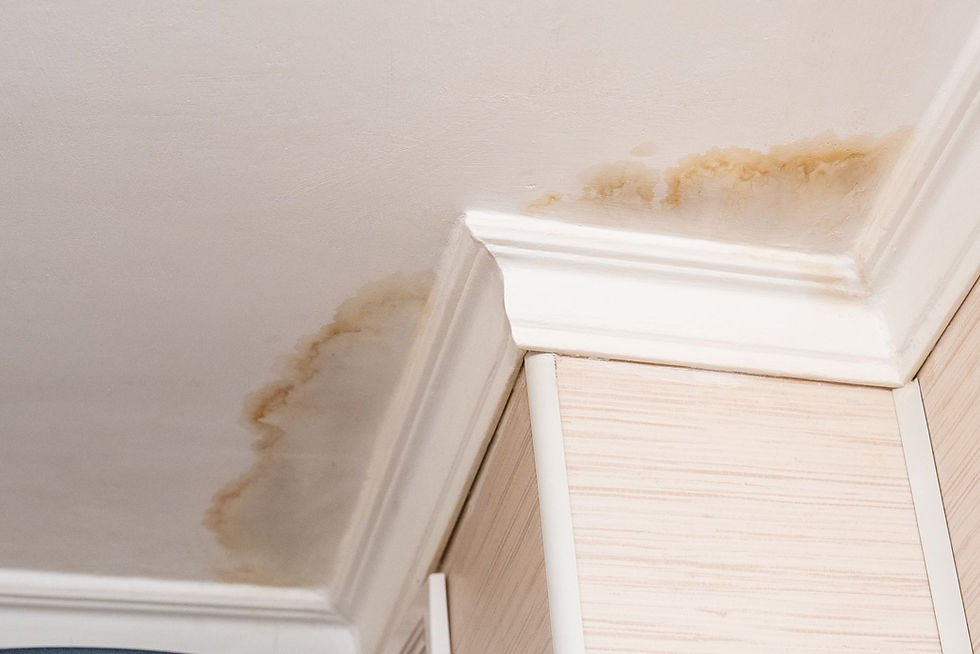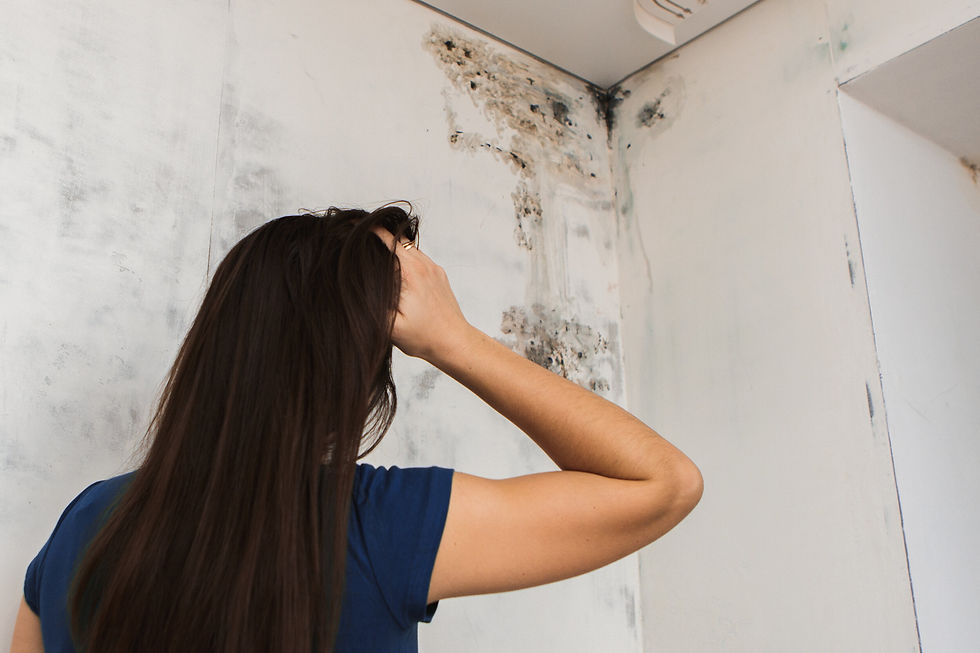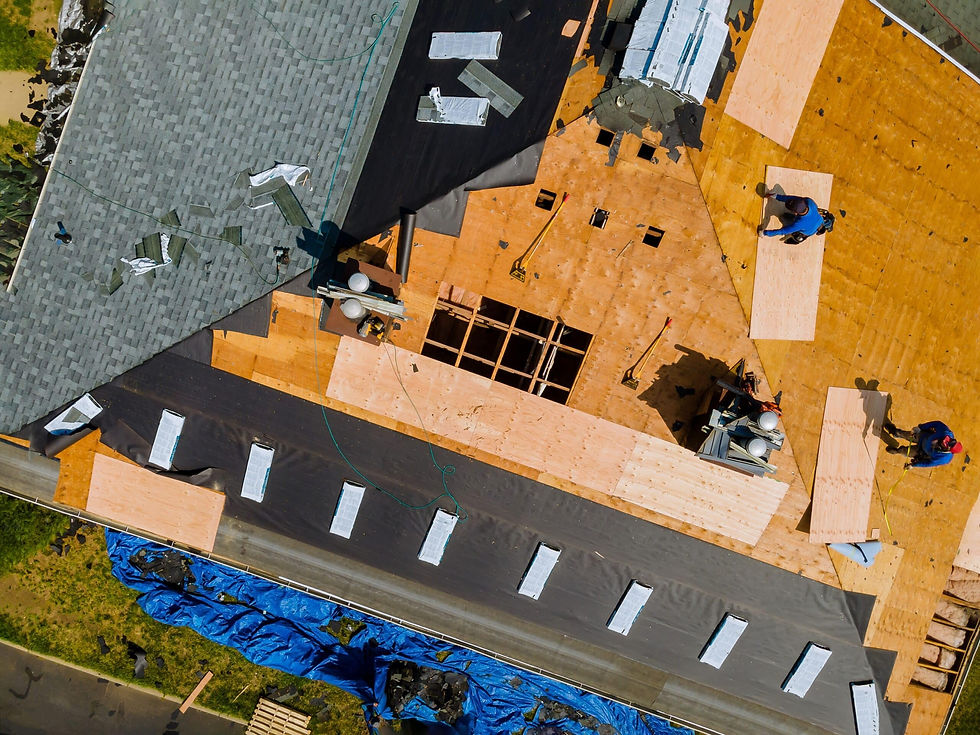Will a Leak in the Roof Cause Mold?
- Growing Texas

- Aug 12
- 5 min read

When homeowners ask, "Will a leak in the roof cause mold?", the short answer is yes — and faster than you might think.
A roof leak is more than just a drip in a bucket; it's a gateway for mold growth, structural damage, and costly repairs. This guide will break down how roof leaks cause mold, what to watch for, how to prevent long-term damage, and when to call in the experts.
How Roof Leaks Lead to Mold Growth
Why Moisture Is Mold's Best Friend
Mold spores are everywhere — in the air, on surfaces, and even in your HVAC system.
On their own, they're harmless. But when they meet moisture from water leaks, they multiply rapidly. A roof leak allows water to soak into insulation, wood beams, and drywall. These organic materials act like a buffet for mold.
Whether the leak is from storm damage, shingle replacement delays, or aging roof materials, water often travels far from the original entry point. This makes it difficult to identify leaks early without professional help from a roofing company.
How Quickly Mold Can Grow After a Leak
In ideal conditions — warmth, moisture, and darkness — mold can begin to grow in 24 to 48 hours.
If you wait even a few days before addressing the issue, you may find yourself dealing with both a roof repair and a costly mold remediation project.
Signs You Have Mold from a Roof Leak
Visible Clues on Ceilings and Walls
Look for water stains on water-damaged ceilings or water-damaged drywall.
These may appear yellow, brown, or black depending on the severity and duration of the leak. Bubbling paint or peeling wallpaper is another clear sign that moisture is present.
Hidden Mold Warning Signs
Not all mold is visible—some hides in attics, behind walls, or beneath flooring.
Musty odors, unexplained allergy symptoms, and worsening asthma can all point to hidden mold. If you've had past roof repairs but never checked for mold, it's worth scheduling an inspection.

The Risks of Ignoring Mold After a Roof Leak
Health Concerns
Mold exposure can trigger nasal congestion, eye irritation, skin rashes, and respiratory problems.
Particular species, such as black mold, may produce mycotoxins that can cause more severe health issues, especially for people with compromised immune systems.
Structural Damage, Home Value Loss, and Roofing System Deterioration
Left untreated, mold can weaken wooden beams, ruin insulation, and cause drywall to crumble.
Over time, this damage can compromise your roof's structure, reduce your home's value, and damage surrounding roofing systems.
Preventing Mold After a Roof Leak
Emergency Actions to Take Immediately
If you suspect or see a roof leak:
Contain the leak with buckets, tarps, or temporary sealants.
Call a roofing company for emergency service.
Remove wet materials (if safe) and start drying the area with fans and dehumidifiers.
Check insulation and attic spaces for moisture.
The goal is to dry everything within 24–48 hours to prevent mold from forming.
Long-Term Roof Maintenance Tips
Prevent leaks before they happen by:
Scheduling annual roof maintenance inspections.
Perform shingle replacement when shingles are missing, curled, or cracked.
Cleaning gutters to prevent water overflow.
Checking flashing around vents, skylights, and chimneys.
Step-by-Step Guide to Identify Leaks Before Mold Appears
Inspect the Attic – Look for damp insulation or wood discoloration.
Check for Stains – Search for spots on ceilings, especially after heavy rain.
Use a Hose Test – Spray sections of the roof to locate entry points.
Call a Pro – A roofing contractor can use thermal imaging to find hidden leaks.
Seasonal Roof Maintenance Checklist
Spring: Inspect for winter storm damage, repair loose shingles.
Summer: Clear gutters, check for sun damage to asphalt shingles.
Fall: Remove leaves from gutters and valleys, check flashing.
Winter: Monitor for ice dams, condensation in attics, and damage from high winds.

Who to Call: Roofing Company vs. Mold Remediation Specialist
If your roof is still leaking, always fix the leak first with a professional roof repair.
Only then should you call a mold remediation specialist to remove contamination. Doing it in reverse risks re-infestation.
Will Insurance Cover Roof Leak Mold Damage?
Whether insurance covers mold cleanup depends on the cause. If a sudden event like storm damage caused the leak, your policy may cover both the roof repair and mold removal.
If neglect caused the leak, coverage is less likely. Always document signs of water-damaged areas with photos and contact your insurance company promptly.
Choosing the Right Roofing Solutions After a Leak
Once a leak in the roof causes a mold situation that is under control, the next decision is whether to choose roof repair or a complete roof replacement. This often depends on the type of roofing material and the extent of the structural damage. For example, asphalt shingles may be patched or replaced individually, while severe damage to metal roofing might require a larger project.
A licensed roofing contractor can assess your roof and recommend the most cost-effective approach. They'll consider the age of your roof, the frequency of roof leaks, and whether high-risk conditions like high winds or poor roofing system design are contributing factors.
Working With Your Insurance Company
If your home suffered storm damage or a leaky roof from a sudden weather event, your insurance company may cover the costs.
Always document signs of water-damaged areas, keep repair receipts, and track changes in your water bill in case it indicates hidden leaks.
Your policy may also cover part of a roof replacement if the damage is severe. Having a trusted roofing contractor handle the inspection can give you peace of mind that all claims are properly filed.
Repair or Replacement: Making the Call
When deciding between repair and replacement, the choice often depends on the type of roof you have and the extent of the damage. Some asphalt shingles can last decades with proper care, but if leaks keep appearing, a full roof replacement might save you money in the long run.
FAQs About Roof Leaks and Mold
Q: How can I quickly identify leaks before mold forms?
A: Inspect your attic and ceilings regularly, especially after storms. Use moisture meters or thermal imaging if possible.
Q: Can small leaks cause mold?
A: Absolutely. Even tiny leaks can saturate insulation and drywall, creating perfect mold conditions.
Q: How much does mold removal cost?
A: Small areas may cost a few hundred dollars, but widespread mold from roof leaks can exceed $5,000.
Q: Will painting over the mold solve the problem?
A: No. Mold must be removed and the moisture source fixed before repainting.
Q: Can insurance deny a claim for roof leak mold?
A: Yes, if they determine the leak was from poor roof maintenance or neglect.
Q: Is shingle replacement worth the cost to prevent mold?
A: Definitely. Replacing damaged shingles is far cheaper than mold remediation.
Final Thoughts
So, will a leak in the roof cause mold? Without quick action, yes — and it can happen in as little as two days.
The best defense is proactive roof maintenance, fast repairs, and proper ventilation. If a leak happens, fix it immediately and dry all affected areas to protect your home's structure, air quality, and value.



Comments